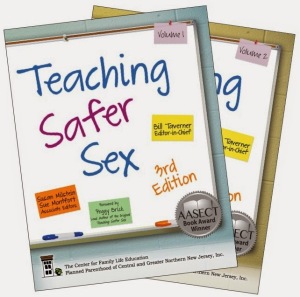Today I’m sitting in the exhibit hall of the Healthy Teen Network conference, contemplating all of these amazing people – both my co-exhibiters and the attendees.
Here are some of the people I’ve met:
Connected Health Solutions
Healthy Futures of Texas
Michigan Adolescent Health Initiative
Teen Empower
Healthy Futures of Texas
Michigan Adolescent Health Initiative
Teen Empower
And this is what I love most about conferences – meeting people, being inspired by their work and connection with the field. One of my favorite conversations from dinner last night was about abstinence and its relevance for all people, of all ages. It reminded me how important shifting the paradigm around abstinence is. And so, given this week’s focus on healthcare quality, I’m going to pull a lesson on abstinence from Teaching Safer Sex:
_____________________________________________________________________
ORAL SEX AND ABSTINENCE:
Examining the Role of Intimacy in Sexual Decisions
By Nora Gelperin, Med
Objectives
By the end of this lesson plan, participants will be able to:
1. Clarify their beliefs about abstinence and whether or not oral sex is congruent with their personal abstinence definitions.
2. Recognize the variety of attitudes about oral sex and abstinence.
3. Examine the role of intimacy in deciding whether or not to engage in oral sex.
Rationale
Many health professionals are concerned about reports of oral sex among young people and its risk of transmitting sexual infections. Once considered intensely intimate, oral sex has more recently been termed “the new third base,” and may hold a variety of meanings for young people today. Some teens view oral sex as congruent with their definition of sexual abstinence, while others do not. This lesson will give participants an opportunity to explore and clarify their beliefs about oral sex and intimacy and how oral sex relates to decisions about abstinence and safer sex.
_____________________________________________________________________
This lesson also reminds me of a conversation I had while training a group of teachers last week about the difference between abstinence and celibacy. One is about a choice for the moment – for one of many potential reasons – while the other is a life choice that is usually far more pervasive and often done for deeply spiritual reasons.
Abstinence from vaginal intercourse, for example, is recommended for women after childbirth. During intense times of interpersonal strife, it is common for both partners in a long-term, monogamous relationship to opt for abstinence. There are so many emotional reasons why people need to pull their sexuality into themselves rather than sharing it with someone else – and place in life is one of them. When we talk about abstinence in these terms, rather than in terms of “until marriage” or “until you’re 18” or “until you’re out of high school” or even “until you’re in love,” we get a very different response from all people – young and old. Why would we relegate abstinence into something that only pre-marital adolescents have access to?







